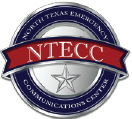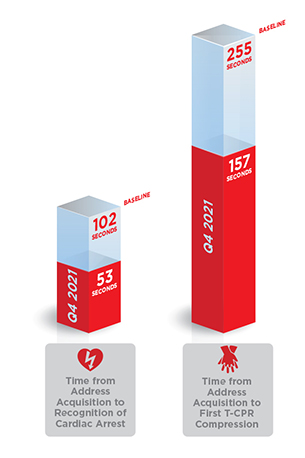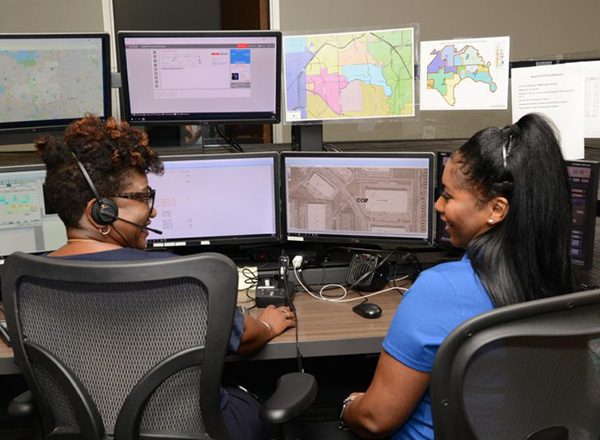About the North Texas Emergency Communications Center
 NTECC was founded in 2014 to serve as the emergency communications center handling all 911 calls and police and fire dispatch for four cities in northwest Dallas County: Addison, Carrollton, Coppell and Farmers Branch. NTECC employs 54 emergency telecommunicators.
NTECC was founded in 2014 to serve as the emergency communications center handling all 911 calls and police and fire dispatch for four cities in northwest Dallas County: Addison, Carrollton, Coppell and Farmers Branch. NTECC employs 54 emergency telecommunicators.
Population Served:
229,069
Annual 9-1-1 calls:
140,221
Annual Non-Traumatic
Cardiac Arrests:
182
CHALLENGE
![]() Justin Northeim, DO, knew the telecommunicators he worked with at the North Texas Emergency Communications Center followed emergency medical dispatch protocols and did a good job providing telephone CPR instructions. But after attending a Resuscitation Academy in Seattle led by some of the world’s leaders in cardiac arrest care, he realized there was a lot he didn’t know, too. Like just how quickly the telecommunicators at NTECC were identifying cardiac arrest and providing CPR instructions to the caller.
Justin Northeim, DO, knew the telecommunicators he worked with at the North Texas Emergency Communications Center followed emergency medical dispatch protocols and did a good job providing telephone CPR instructions. But after attending a Resuscitation Academy in Seattle led by some of the world’s leaders in cardiac arrest care, he realized there was a lot he didn’t know, too. Like just how quickly the telecommunicators at NTECC were identifying cardiac arrest and providing CPR instructions to the caller.
“CPR being delivered in the first minutes after cardiac arrest can drastically improve a patient’s chance of survival. Before going to the Resuscitation Academy, we didn’t focus on the time period before EMS arrives on scene,” says Northeim, an emergency physician and medical director for several fire, EMS, law enforcement and emergency communications centers in Texas. “But in actuality, our fire crews often will not arrive until eight to ten minutes after the cardiac arrest. In order to improve their hopes of survival, we needed to focus on what happens during the 911 call itself.”
Chief Gregg Salmi of the Carrollton Fire Department–one of the agencies dispatched by NTECC–remembers members of his team returning from the Resuscitation Academy and sharing what they’d learned about just how much of a difference the rate and depth of chest compressions can make, even during those initial few minutes before professional responders arrive on scene. For Chief Salmi, who had helped start the department’s public CPR education program decades before and was well-versed in the concepts of high-performance CPR, it was a bit of a revelation.
“We decided we could place even more focus on addressing the timeframe between cardiac arrest and our arrival on scene,” Chief Salmi says.
SOLUTION
![]() Around the same time, Northeim and Salmi became aware of RQI Partners and its RQI Telecommunicator program. They mentioned this innovative training and quality improvement program to the leadership team at NTECC, who saw the potential benefits of the program right away.
Around the same time, Northeim and Salmi became aware of RQI Partners and its RQI Telecommunicator program. They mentioned this innovative training and quality improvement program to the leadership team at NTECC, who saw the potential benefits of the program right away.
RQI T-CPR delivers quarterly education, with robust analytics to pinpoint areas of improvement and opportunities for growth. Because RQI T-CPR’s digital platform is synced with the latest American Heart Association guidelines and updates, it verifies that telecommunicators are competent to recognize cardiac arrest and deliver high-quality CPR instructions–something that has taken on an even greater importance following the Texas legislature’s enactment of a law requiring T-CPR training for all emergency telecommunicators. RQI T-CPR is also the preferred solution of the International Academies of Emergency Dispatch, meaning the NTECC telecommunicators, who use Priority Dispatch’s ProQA software, receive two hours of EMD continuing education credit annually.
“Our quality improvement and our training is the backbone of our operation,” says Terry Goswick, NTECC’s executive director. “We have a quality improvement process that’s not disciplinary but supportive. RQI T-CPR, with its enhanced training and the formalized call review process, really intrigued me. But moreover, it was quantitative: you had some key objectives you could quantify and say whether it was a success or not a success.”
Not surprisingly for an agency whose vision is to be “the model of regional emergency communications,” the telecommunicators at NTECC mostly were enthusiastic about trying RQI T-CPR. “The only thing our team hates more than change is leaving things the same,” jokes Goswick. “We’re not scared to try something new if it’s going to do good things for the community and for our people.”
RESULTS
![]() After one year of partnering with RQI, those numbers have proven the RQI T-CPR programs value, Goswick says. NTECC implemented RQI T-CPR in October 2020. By the summer of 2021, the agency’s 911 telecommunicators were identifying cardiac arrests faster and getting callers to initiate chest compressions sooner–two metrics they weren’t even looking at prior to using RQI T-CPR.
After one year of partnering with RQI, those numbers have proven the RQI T-CPR programs value, Goswick says. NTECC implemented RQI T-CPR in October 2020. By the summer of 2021, the agency’s 911 telecommunicators were identifying cardiac arrests faster and getting callers to initiate chest compressions sooner–two metrics they weren’t even looking at prior to using RQI T-CPR.

Building Confidence
Since starting with the RQI T-CPR program, NTECC has focused on more quickly recognizing cardiac arrest as well as overcoming potential barriers to callers performing CPR. Almost immediately after going through the initial RQI T-CPR training modules, NTECC’s telecommunicators became more comfortable handling even the most difficult cardiac arrest calls.
“The big thing that I get a lot of feedback on was just the confidence that it put in the staff,” says Heather Herriage, NTECC’s deputy director. “They come out feeling so much better prepared, and they talk about that–that’s almost better than the data.”
In fact, in the spring of 2021, one of NTECC’s emergency telecommunicators had just finished her live scenario training with an RQI T-CPR coach when she answered a 911 call for a newborn who wasn’t breathing. She also faced a language barrier, and had to use a language line translator to help her determine what was happening and to talk the parents through CPR instructions. The call-taker, Alice, credits that earlier session with the RQI T-CPR coach with giving her the confidence she needed to handle the challenging situation and help save the baby’s life. “It made it so much easier and more comfortable to navigate,” she says. “By the time I finished, I felt good about what I had learned and what I could bring to real-world situations going forward.
An Easy Decision
After the first year with RQI T-CPR, the decision to continue with the program was an easy one for NTECC’s leaders and the fire and police chiefs in the communities it serves. NTECC’s board, made up of the city managers of those four cities, approved funding to continue using RQI T-CPR training and to assist with cardiac arrest case reviews and analytics.
“It was not in doubt for me: it’s proven its worth,” Goswick says. “The first day we used it, it saved a life.” Northeim, the medical director, agrees.
“We quickly became aware of where we could do better, and in less than a year improved across the board,” he says. “We know that we will see more patients walking out of the hospital after cardiac arrest thanks to our partnership with RQI. That’s great for our patients, and also for our dedicated 911 telecommunicators who know they’re making a real difference in people’s lives.”
For more information, visit RQIPartners.com/RQIT









